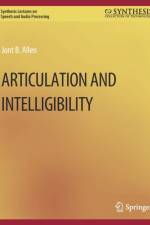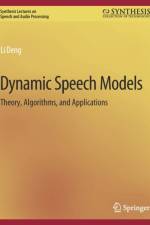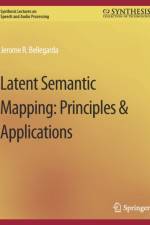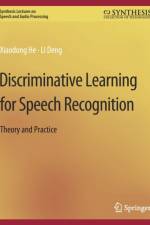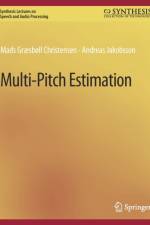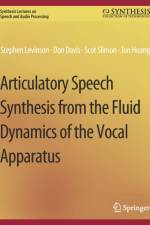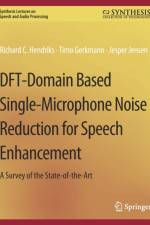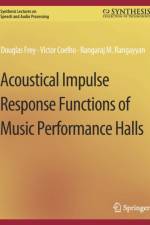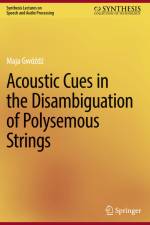Bøger i Synthesis Lectures on Speech and Audio Processing serien
-
371,95 kr. This book focuses on a class of single-channel noise reduction methods that are performed in the frequency domain via the short-time Fourier transform (STFT). The simplicity and relative effectiveness of this class of approaches make them the dominant choice in practical systems. Even though many popular algorithms have been proposed through more than four decades of continuous research, there are a number of critical areas where our understanding and capabilities still remain quite rudimentary, especially with respect to the relationship between noise reduction and speech distortion. All existing frequency-domain algorithms, no matter how they are developed, have one feature in common: the solution is eventually expressed as a gain function applied to the STFT of the noisy signal only in the current frame. As a result, the narrowband signal-to-noise ratio (SNR) cannot be improved, and any gains achieved in noise reduction on the fullband basis come with a price to pay, which is speechdistortion. In this book, we present a new perspective on the problem by exploiting the difference between speech and typical noise in circularity and interframe self-correlation, which were ignored in the past. By gathering the STFT of the microphone signal of the current frame, its complex conjugate, and the STFTs in the previous frames, we construct several new, multiple-observation signal models similar to a microphone array system: there are multiple noisy speech observations, and their speech components are correlated but not completely coherent while their noise components are presumably uncorrelated. Therefore, the multichannel Wiener filter and the minimum variance distortionless response (MVDR) filter that were usually associated with microphone arrays will be developed for single-channel noise reduction in this book. This might instigate a paradigm shift geared toward speech distortionless noise reduction techniques. Table of Contents: Introduction / Problem Formulation / Performance Measures / Linear and Widely Linear Models / Optimal Filters with Model 1 / Optimal Filters with Model 2 / Optimal Filters with Model 3 / Optimal Filters with Model 4 / Experimental Study
- Bog
- 371,95 kr.
-
334,95 kr. Immediately following the Second World War, between 1947 and 1955, several classic papers quantified the fundamentals of human speech information processing and recognition. In 1947 French and Steinberg published their classic study on the articulation index. In 1948 Claude Shannon published his famous work on the theory of information. In 1950 Fletcher and Galt published their theory of the articulation index, a theory that Fletcher had worked on for 30 years, which integrated his classic works on loudness and speech perception with models of speech intelligibility. In 1951 George Miller then wrote the first book Language and Communication, analyzing human speech communication with Claude Shannon's just published theory of information. Finally in 1955 George Miller published the first extensive analysis of phone decoding, in the form of confusion matrices, as a function of the speech-to-noise ratio. This work extended the Bell Labs' speech articulation studies with ideas from Shannon's Information theory. Both Miller and Fletcher showed that speech, as a code, is incredibly robust to mangling distortions of filtering and noise. Regrettably much of this early work was forgotten. While the key science of information theory blossomed, other than the work of George Miller, it was rarely applied to aural speech research. The robustness of speech, which is the most amazing thing about the speech code, has rarely been studied. It is my belief (i.e., assumption) that we can analyze speech intelligibility with the scientific method. The quantitative analysis of speech intelligibility requires both science and art. The scientific component requires an error analysis of spoken communication, which depends critically on the use of statistics, information theory, and psychophysical methods. The artistic component depends on knowing how to restrict the problem in such a way that progress may be made. It is critical to tease out the relevant from the irrelevant and dig for the key issues. This will focus us on the decoding of nonsense phonemes with no visual component, which have been mangled by filtering and noise. This monograph is a summary and theory of human speech recognition. It builds on and integrates the work of Fletcher, Miller, and Shannon. The long-term goal is to develop a quantitative theory for predicting the recognition of speech sounds. In Chapter 2 the theory is developed for maximum entropy (MaxEnt) speech sounds, also called nonsense speech. In Chapter 3, context is factored in. The book is largely reflective, and quantitative, with a secondary goal of providing an historical context, along with the many deep insights found in these early works.
- Bog
- 334,95 kr.
-
371,95 kr. Speech dynamics refer to the temporal characteristics in all stages of the human speech communication process. This speech "e;chain"e; starts with the formation of a linguistic message in a speaker's brain and ends with the arrival of the message in a listener's brain. Given the intricacy of the dynamic speech process and its fundamental importance in human communication, this monograph is intended to provide a comprehensive material on mathematical models of speech dynamics and to address the following issues: How do we make sense of the complex speech process in terms of its functional role of speech communication? How do we quantify the special role of speech timing? How do the dynamics relate to the variability of speech that has often been said to seriously hamper automatic speech recognition? How do we put the dynamic process of speech into a quantitative form to enable detailed analyses? And finally, how can we incorporate the knowledge of speech dynamics into computerized speech analysis and recognition algorithms? The answers to all these questions require building and applying computational models for the dynamic speech process. What are the compelling reasons for carrying out dynamic speech modeling? We provide the answer in two related aspects. First, scientific inquiry into the human speech code has been relentlessly pursued for several decades. As an essential carrier of human intelligence and knowledge, speech is the most natural form of human communication. Embedded in the speech code are linguistic (as well as para-linguistic) messages, which are conveyed through four levels of the speech chain. Underlying the robust encoding and transmission of the linguistic messages are the speech dynamics at all the four levels. Mathematical modeling of speech dynamics provides an effective tool in the scientific methods of studying the speech chain. Such scientific studies help understand why humans speak as they do and how humans exploit redundancy and variability by way of multitiered dynamic processes to enhance the efficiency and effectiveness of human speech communication. Second, advancement of human language technology, especially that in automatic recognition of natural-style human speech is also expected to benefit from comprehensive computational modeling of speech dynamics. The limitations of current speech recognition technology are serious and are well known. A commonly acknowledged and frequently discussed weakness of the statistical model underlying current speech recognition technology is the lack of adequate dynamic modeling schemes to provide correlation structure across the temporal speech observation sequence. Unfortunately, due to a variety of reasons, the majority of current research activities in this area favor only incremental modifications and improvements to the existing HMM-based state-of-the-art. For example, while the dynamic and correlation modeling is known to be an important topic, most of the systems nevertheless employ only an ultra-weak form of speech dynamics; e.g., differential or delta parameters. Strong-form dynamic speech modeling, which is the focus of this monograph, may serve as an ultimate solution to this problem. After the introduction chapter, the main body of this monograph consists of four chapters. They cover various aspects of theory, algorithms, and applications of dynamic speech models, and provide a comprehensive survey of the research work in this area spanning over past 20~years. This monograph is intended as advanced materials of speech and signal processing for graudate-level teaching, for professionals and engineering practioners, as well as for seasoned researchers and engineers specialized in speech processing
- Bog
- 371,95 kr.
-
371,95 kr. Latent semantic mapping (LSM) is a generalization of latent semantic analysis (LSA), a paradigm originally developed to capture hidden word patterns in a text document corpus. In information retrieval, LSA enables retrieval on the basis of conceptual content, instead of merely matching words between queries and documents. It operates under the assumption that there is some latent semantic structure in the data, which is partially obscured by the randomness of word choice with respect to retrieval. Algebraic and/or statistical techniques are brought to bear to estimate this structure and get rid of the obscuring "e;"e;noise."e;"e; This results in a parsimonious continuous parameter description of words and documents, which then replaces the original parameterization in indexing and retrieval. This approach exhibits three main characteristics:-Discrete entities (words and documents) are mapped onto a continuous vector space;-This mapping is determined by global correlation patterns; and-Dimensionality reduction is an integral part of the process. Such fairly generic properties are advantageous in a variety of different contexts, which motivates a broader interpretation of the underlying paradigm. The outcome (LSM) is a data-driven framework for modeling meaningful global relationships implicit in large volumes of (not necessarily textual) data. This monograph gives a general overview of the framework, and underscores the multifaceted benefits it can bring to a number of problems in natural language understanding and spoken language processing. It concludes with a discussion of the inherent tradeoffs associated with the approach, and some perspectives on its general applicability to data-driven information extraction. Contents: I. Principles / Introduction / Latent Semantic Mapping / LSM Feature Space / Computational Effort / Probabilistic Extensions / II. Applications / Junk E-mail Filtering / Semantic Classification / Language Modeling / Pronunciation Modeling / Speaker Verification / TTS Unit Selection / III. Perspectives / Discussion / Conclusion / Bibliography
- Bog
- 371,95 kr.
-
371,95 kr. In this book, we introduce the background and mainstream methods of probabilistic modeling and discriminative parameter optimization for speech recognition. The specific models treated in depth include the widely used exponential-family distributions and the hidden Markov model. A detailed study is presented on unifying the common objective functions for discriminative learning in speech recognition, namely maximum mutual information (MMI), minimum classification error, and minimum phone/word error. The unification is presented, with rigorous mathematical analysis, in a common rational-function form. This common form enables the use of the growth transformation (or extended Baum-Welch) optimization framework in discriminative learning of model parameters. In addition to all the necessary introduction of the background and tutorial material on the subject, we also included technical details on the derivation of the parameter optimization formulas for exponential-family distributions, discrete hidden Markov models (HMMs), and continuous-density HMMs in discriminative learning. Selected experimental results obtained by the authors in firsthand are presented to show that discriminative learning can lead to superior speech recognition performance over conventional parameter learning. Details on major algorithmic implementation issues with practical significance are provided to enable the practitioners to directly reproduce the theory in the earlier part of the book into engineering practice. Table of Contents: Introduction and Background / Statistical Speech Recognition: A Tutorial / Discriminative Learning: A Unified Objective Function / Discriminative Learning Algorithm for Exponential-Family Distributions / Discriminative Learning Algorithm for Hidden Markov Model / Practical Implementation of Discriminative Learning / Selected Experimental Results / Epilogue / Major Symbols Used in the Book and Their Descriptions / Mathematical Notation / Bibliography
- Bog
- 371,95 kr.
-
371,95 kr. Periodic signals can be decomposed into sets of sinusoids having frequencies that are integer multiples of a fundamental frequency. The problem of finding such fundamental frequencies from noisy observations is important in many speech and audio applications, where it is commonly referred to as pitch estimation. These applications include analysis, compression, separation, enhancement, automatic transcription and many more. In this book, an introduction to pitch estimation is given and a number of statistical methods for pitch estimation are presented. The basic signal models and associated estimation theoretical bounds are introduced, and the properties of speech and audio signals are discussed and illustrated. The presented methods include both single- and multi-pitch estimators based on statistical approaches, like maximum likelihood and maximum a posteriori methods, filtering methods based on both static and optimal adaptive designs, and subspace methods based on the principles of subspace orthogonality and shift-invariance. The application of these methods to analysis of speech and audio signals is demonstrated using both real and synthetic signals, and their performance is assessed under various conditions and their properties discussed. Finally, the estimators are compared in terms of computational and statistical efficiency, generalizability and robustness. Table of Contents: Fundamentals / Statistical Methods / Filtering Methods / Subspace Methods / Amplitude Estimation
- Bog
- 371,95 kr.
-
396,95 kr. This book introduces the theory, algorithms, and implementation techniques for efficient decoding in speech recognition mainly focusing on the Weighted Finite-State Transducer (WFST) approach. The decoding process for speech recognition is viewed as a search problem whose goal is to find a sequence of words that best matches an input speech signal. Since this process becomes computationally more expensive as the system vocabulary size increases, research has long been devoted to reducing the computational cost. Recently, the WFST approach has become an important state-of-the-art speech recognition technology, because it offers improved decoding speed with fewer recognition errors compared with conventional methods. However, it is not easy to understand all the algorithms used in this framework, and they are still in a black box for many people. In this book, we review the WFST approach and aim to provide comprehensive interpretations of WFST operations and decoding algorithms to help anyone who wants to understand, develop, and study WFST-based speech recognizers. We also mention recent advances in this framework and its applications to spoken language processing. Table of Contents: Introduction / Brief Overview of Speech Recognition / Introduction to Weighted Finite-State Transducers / Speech Recognition by Weighted Finite-State Transducers / Dynamic Decoders with On-the-fly WFST Operations / Summary and Perspective
- Bog
- 396,95 kr.
-
371,95 kr. This book addresses the problem of articulatory speech synthesis based on computed vocal tract geometries and the basic physics of sound production in it. Unlike conventional methods based on analysis/synthesis using the well-known source filter model, which assumes the independence of the excitation and filter, we treat the entire vocal apparatus as one mechanical system that produces sound by means of fluid dynamics. The vocal apparatus is represented as a three-dimensional time-varying mechanism and the sound propagation inside it is due to the non-planar propagation of acoustic waves through a viscous, compressible fluid described by the Navier-Stokes equations. We propose a combined minimum energy and minimum jerk criterion to compute the dynamics of the vocal tract during articulation. Theoretical error bounds and experimental results show that this method obtains a close match to the phonetic target positions while avoiding abrupt changes in the articulatory trajectory. The vocal folds are set into aerodynamic oscillation by the flow of air from the lungs. The modulated air stream then excites the moving vocal tract. This method shows strong evidence for source-filter interaction. Based on our results, we propose that the articulatory speech production model has the potential to synthesize speech and provide a compact parameterization of the speech signal that can be useful in a wide variety of speech signal processing problems. Table of Contents: Introduction / Literature Review / Estimation of Dynamic Articulatory Parameters / Construction of Articulatory Model Based on MRI Data / Vocal Fold Excitation Models / Experimental Results of Articulatory Synthesis / Conclusion
- Bog
- 371,95 kr.
-
334,95 kr. As speech processing devices like mobile phones, voice controlled devices, and hearing aids have increased in popularity, people expect them to work anywhere and at any time without user intervention. However, the presence of acoustical disturbances limits the use of these applications, degrades their performance, or causes the user difficulties in understanding the conversation or appreciating the device. A common way to reduce the effects of such disturbances is through the use of single-microphone noise reduction algorithms for speech enhancement. The field of single-microphone noise reduction for speech enhancement comprises a history of more than 30 years of research. In this survey, we wish to demonstrate the significant advances that have been made during the last decade in the field of discrete Fourier transform domain-based single-channel noise reduction for speech enhancement.Furthermore, our goal is to provide a concise description of a state-of-the-art speech enhancement system, and demonstrate the relative importance of the various building blocks of such a system. This allows the non-expert DSP practitioner to judge the relevance of each building block and to implement a close-to-optimal enhancement system for the particular application at hand. Table of Contents: Introduction / Single Channel Speech Enhancement: General Principles / DFT-Based Speech Enhancement Methods: Signal Model and Notation / Speech DFT Estimators / Speech Presence Probability Estimation / Noise PSD Estimation / Speech PSD Estimation / Performance Evaluation Methods / Simulation Experiments with Single-Channel Enhancement Systems / Future Directions
- Bog
- 334,95 kr.
-
519,95 kr. Digital measurement of the analog acoustical parameters of a music performance hall is difficult. The aim of such work is to create a digital acoustical derivation that is an accurate numerical representation of the complex analog characteristics of the hall. The present study describes the exponential sine sweep (ESS) measurement process in the derivation of an acoustical impulse response function (AIRF) of three music performance halls in Canada. It examines specific difficulties of the process, such as preventing the external effects of the measurement transducers from corrupting the derivation, and provides solutions, such as the use of filtering techniques in order to remove such unwanted effects. In addition, the book presents a novel method of numerical verification through mean-squared error (MSE) analysis in order to determine how accurately the derived AIRF represents the acoustical behavior of the actual hall.
- Bog
- 519,95 kr.
-
441,95 kr. This book provides an analysis of acoustic features of polysemous strings and an implementation of a speech disambiguation program based on the phonetic information. Throughout the book, the term ¿polysemous string¿ refers to idioms with plausible literal interpretations, restrictive and non¿restrictive relative clauses, and the same expressions used as quotations and appearing in a non¿quotational context. The author explains how, typically, context is sufficient to determine the intended meaning. But there is enough evidence in psycholinguistic and phonetic literature to suspect that these superficially identical strings exhibit different acoustic features. In the experiment presented in the book, the participants were asked to read short excerpts containing corresponding elements of polysemous strings placed in the same intonational position. The acoustic analyses of ditropic pairs and subsequent statistical tests revealed that there is almost no difference in the duration, pitch, or intensity in literal and figurative interpretations. However, the analysis of relative clauses and quotations demonstrated that speakers are more likely to use acoustic cues to differentiate between the two possible readings. The book argues that the acoustic analysis of polysemous phrases could be successfully implemented in designing automatic speech recognition systems in order to improve their performance in disambiguating polysemous phrases.Analyzes acoustic features of polysemous strings and an implementation of a speech disambiguation programIncludes evidence that superficially identical strings exhibit different acoustic featuresArgues that acoustic analysis of polysemous phrases can be successfully implemented in automatic speech recognition
- Bog
- 441,95 kr.


